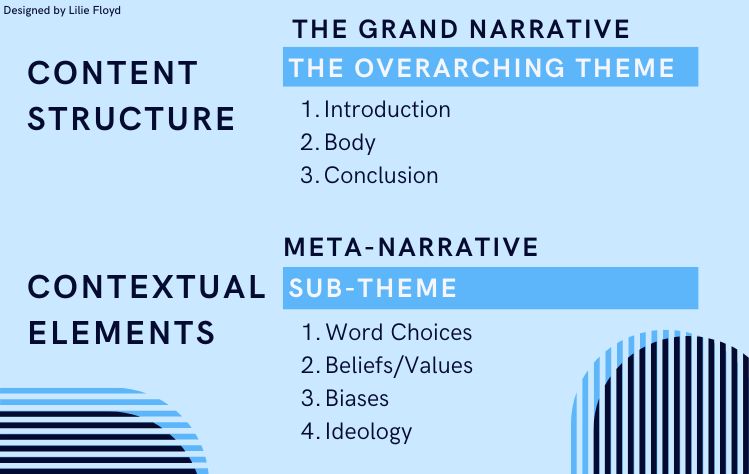Digital Publishing in Education
July 03, 2024
Content Structure Diagram

Image Transcript
Designed by Lilie Floyd
Content Structure, The Grand Narrative, The Overarching Theme. 1. Introduction 2. Body 3. Conclusion
Contextual Elements, Meta-Narrative, Sub-Theme, 1. Word Choices 2. Beliefs/Values 3. Biases 4. Ideology
 Digital publishing is a new form and format of academic expression in education (Sean Michael Morris and Jesse Stommel, 2018). It is designed for an ongoing exchange of information between the author and audience
using digital tools and technologies. As practitioners in the internet age, educators
share their thoughts and ways of thinking with members of the public for their immediate
feedback on issues of concern, adding perspectives shared by members in the group
to this conversation.
Digital publishing is a new form and format of academic expression in education (Sean Michael Morris and Jesse Stommel, 2018). It is designed for an ongoing exchange of information between the author and audience
using digital tools and technologies. As practitioners in the internet age, educators
share their thoughts and ways of thinking with members of the public for their immediate
feedback on issues of concern, adding perspectives shared by members in the group
to this conversation.
What is new? This means the authors have control over their own narratives and can determine the structure of how stories are told when compared to traditional academic writing. This also means that the authors are storytellers making use of key elements in the storyline to convey the message. Key elements of a narrative include 1) the overarching theme/sub-themes, 2) the main plot/sub-plots, 3) characterization of the stakeholders involved and 4) conclusion.
By strictly following the structure to tell these stories, the authors develop the main plot and use the overarching theme to share their thoughts by commenting and driving the grand narrative. By communicating, coordinating and cooperating with members in the community, the authors add their perspectives in the sub-plots. Stories in these sub-plots reflect and represent 1) the language (word choices) they speak about a subject 2) how members in a community act, behave and interact with one another and 3) what they believe in, value and idealize.
In fact, doctoral programs in education could benefit from digital publishing for sharing research findings. For example, to earn a doctoral degree in education, the candidates can submit a research report and a digital portfolio, rather than a dissertation.
The research report is where the candidates discuss the research question, establishing the premise of the storyline.
A PREMISE is where the stories begin. It is the origin of the study.
A PREMISE can be a socio-cultural issue you care deeply about or a gap of knowledge that you wish to contribute to the field.
The doctoral digital portfolio is a compilation of digital media contents in which the candidates present a digital media presentation of their perspectives and findings. Part of the intent of the portfolio is to allow for digital publishing:
1. What motivates you to tell these stories? (INTENT of the candidate)
The INTENT of the candidate is the PURPOSE of the study.
The INTENT will determine the channel mix for the candidate to tell these stories. This is because digital media exist in multiple forms such as word texts, visual texts and multimedia texts.
2. What are key elements in the grand narrative? (CONTENTS in the main plot)
CONTENTS consist of three elements
- An INTRODUCTION to the STORY allows the candidates to clearly state the purpose of telling these stories using a selected channel.
- The STORY’S BODY allows the candidates to demonstrate the use of audience language to tell their stories formulated by the overarching theme and sub-theme.
- The CONCLUSION of the story allows the candidate to flesh out their thoughts by responding to comments and feedback from members in real time.
3. What stories will be included in the meta-narrative? (CONTEXT in the sub-plots)
CONTEXT is the online environment in which the exchange of information and feedback takes place. The candidate can choose to share thoughts on their personal social media accounts and to join a conversation on an existing online forum such as groups across different social platforms or dedicated online forum with gatekeepers like Reddit. Accord, etc.
CONTEXT is an ecosystem that is governed by a set of rules agreed by members of each community, providing a common practice of how members speak, act, behave and interact in this online society.
4. How will the story end? (CONCLUSION of the story)
CONCLUSION is an illustration of common practices shared by members in the community in a real situation in the real world.
CONCLUSION is the preferred meaning of the message that the candidate wants the public to take away from this study.
Consequently, digital portfolios clearly put the process of digital publishing into practice. Educational practitioners know the conventions to compose these texts on screen in real-time settings and need to carry a conversation with members in a public space on the Internet. They use the grand narrative to structure the messaging of the storyline.
Importantly, educational practitioners are leading a new form and format of academic writing. To earn a Doctor of Education degree, candidates have the option to write a traditional dissertation in academic setting and defend the premise of their story, or explore their research questions via a public forum using digital media, making the academic knowledge construction processes more accessible to all.
